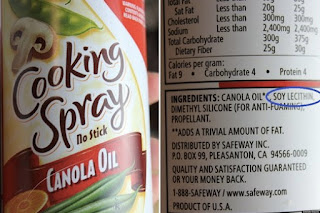What is Lecithin? And is it Good or Bad for Me?
What in the world is lecithin?
In 1845, French chemist and pharmacist Theodore Gobley isolated a fatty, yellowish substance from an egg yoke. He named it phosphatidylcholine lecithine and it’s been injected into our foods ever since.
Today, “lecithin” is a generic term applied to any yellowish, fatty substance that naturally occurs in plant and animal tissues – “a mixture of phospholipids and oil.” In the body, it supports cell membrane health after breaking down into choline; in food manufacturing settings, it’s used as a smoothing agent, as an emulsifier, to repel stickiness, and as a generally homogenizing liquid.
Most of the time, lecithin is chemically extracted from largely available, inexpensive sources like canola, eggs, milk, or sunflowers, and most commonly soy.
Lecithin is often added to animal feed as a fat and protein source. It also has applications in the pharmaceutical industry (it makes your pills swallowable) and in the paint industry (it makes a great protective coat). But most of the time, lecithin crosses our paths as an additive in commercially produced foods.
Check your grocery labels and you’ll find it doing all the hard work in your nonstick cooking spray, or as a dispersing agent in the mass produced breads you pick up in the baked goods aisle. Lecithin is responsible for making a lot of the commercially produced foods that we eat soft, tasty and long-lasting. It keeps our chocolate from separating and makes our salad dressings smooth.
Is it bad for me?
As a standalone, lecithin is essentially harmless. It’s very easy for the body to digest and metabolize and is often sold as an herbal supplement on its own. A number of clinical trials have found additional benefits of lecithin, ranging from being an effective aid in treating liver disease, managing high cholesterol or even preventing dementia by supporting neurotransmission in the brain.
However, many experts suggest that we need to further analyze the variables that surround it.

Phytoestrogens
Soy is pretty commonly known to carry a number of phytoestrogens, a substance that can confuse natural hormonal processes and even lower sperm count. For this reason, it’s often recommended that we avoid soy products and keep those phytoestrogens very minimal. However, soy lecithin isn’t where the problem lies – at least as far as we know today; for generally healthy people the trace amounts of phytoestrogens shouldn’t be an issue.
GMOs
Most of the soy that is grown in the United States is genetically modified – a process that produces immunogenic proteins and can cause DNA disruptions. Lucky for us, soy lecithin contains very little soy protein (some sources include none at all), so this isn’t too desperate a concern.
Toxins
Because lecithin is extracted from raw material through a chemical solvent (usually hexane) there is some concern that chemicals may transfer to the final product. The FDA doesn’t regulate the amount of hexane residue left in commercial foods after-the-fact, so it’s possible concentrations are indeed leftover.
The Final Verdict
Most experts seem to agree that lecithin, consumed by a healthy person within reasonable amounts is perfectly harmless. Possible negatives are neutralized by the very fact that they show up in such small amounts that pale in comparison to the other toxins and chemicals we encounter every day.
However, in the end it just depends. If you have a soy allergy, are pregnant or are a breast cancer survivor you may want to steer clear, just to be on the safe side; or consider switching to clean eating principles and avoid processed foods all together!
By: Lauren Bowen October 20, 2016
source: www.care2.com



Comments
Post a Comment